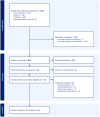Association between body mass index and the risk of bacterial vaginosis: a systematic review and meta-analysis
- PMID: 40901098
- PMCID: PMC12401329
- DOI: 10.1097/MS9.0000000000003655
Association between body mass index and the risk of bacterial vaginosis: a systematic review and meta-analysis
Abstract
Introduction: Bacterial vaginosis, resulting from vaginal microbiota imbalance and lactobacilli depletion, is the leading cause of abnormally appearing discharge in reproductive-aged women. Bacterial vaginosis is also associated with risk for sexually transmitted infections, preterm birth, and pelvic inflammatory disease. This meta-analysis assessed the association between the risk of bacterial vaginosis (BV) and body mass index (BMI).
Methods: We systematically searched electronic databases using terms for weight, vaginosis, obesity, and BMI. We also reviewed gray literature, reference lists, and trials registries and sought the advice of experts. We calculated the overall odds ratios (OR) and the 95% confidence intervals (CI) using fixed-effect model for homogenous data and random-effects models for heterogenous data.
Results: Eight observational studies (n = 22 190) were included, with quality assessment scores ranging from 7 to 9. Compared with normal-weight women (BMI 18.5-24.9), underweight women (BMI <18.5) had significantly higher prevalence of bacterial vaginosis (OR: 1.23; 95% CI: 1.12-1.36; P < 0.001). No significant associations were found for overweight (OR: 1.19; 95% CI: 0.95-1.48; P = 0.13) or obesity (OR: 1.29; 95% CI: 0.91-1.82; P = 0.15).
Conclusion: Our findings suggest a significant association between underweight status and an increased likelihood of being diagnosed with bacterial vaginosis. However, causality cannot be established due to the observational nature of the included studies. Further prospective research is needed to confirm this relationship.
Keywords: bacterial vaginosis; body mass index; microbiota; overweight; risk factor; underweight.
Copyright © 2025 The Author(s). Published by Wolters Kluwer Health, Inc.
Conflict of interest statement
The authors declare no conflict of interests.
Figures




References
-
- Fredricks DN, Fiedler TL, Marrazzo JM. molecular identification of bacteria associated with bacterial vaginosis. N Engl J Med 2005;353:1899–911. - PubMed
-
- Allsworth JE, Peipert JF. Prevalence of bacterial vaginosis: 2001-2004 national health and nutrition examination survey data. Obstet Gynecol 2007;109:114–20. - PubMed
-
- Allsworth JE, Peipert JF. Severity of bacterial vaginosis and the risk of sexually transmitted infection. Am J Obstet Gynecol 2011;205:113.e1–113.e6.
-
- Haggerty CL, Hillier SL, Bass DC, et al. Bacterial vaginosis and anaerobic bacteria are associated with endometritis. Clin Infect Dis 2004;39:990–95. - PubMed
LinkOut - more resources
Full Text Sources
